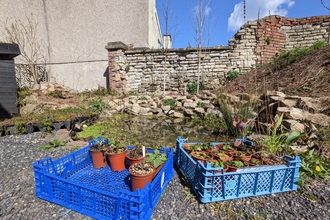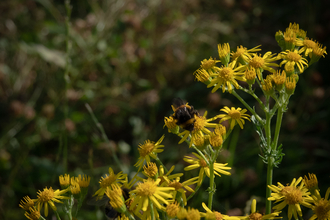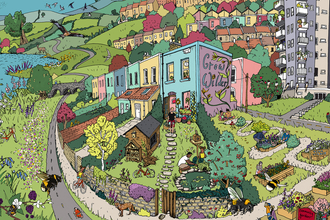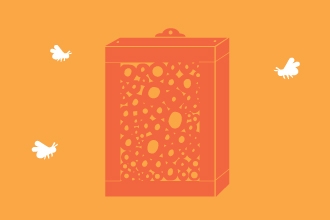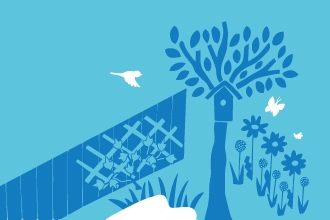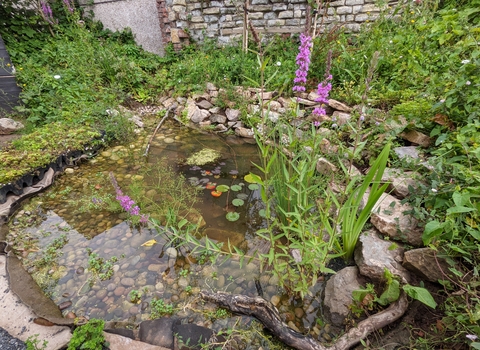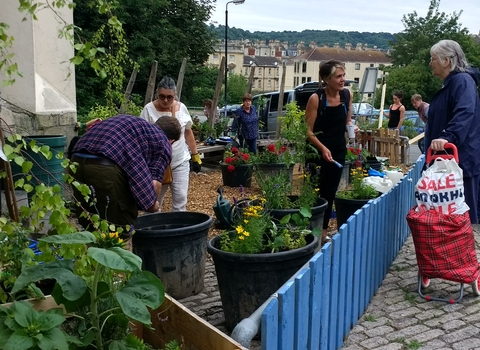
Stephanie Chadwick
Stoke Bishop Church of England school
Stoke Bishop Church of England School
Name: Stoke Bishop Church of England Primary School
Category: Education
Area: Bristol, BS9
Stoke Bishop Church of England school was the wildlife gardening competition winner 2024!
Tell us what you or your group love about your garden
Claire: Our wildlife pond garden is a really special place at our school. It has taken 3 years to develop from an abandoned area into a thriving wildlife haven. It has brought the whole school community together with helpers from the PTA, pupils, teachers and parents. The garden has become a calm, green, safe space for many of our children who may need timeout from a busy classroom. It is also an incredible learning resource for many educational projects.
What makes your garden wildlife friendly?
Claire: The wildlife garden has a large variety of habitats. We have pollinator friendly plants, hazel trees, a pond with oxygenating and marginal plants which are important habitats for breeding. There is also a small 'sloped beach' area which allows easy access for wildlife. Children have created bird feeders and a bug hotel, we have also left 'wilder' areas with hedgerows for larger animals and birds. A compost area has also become an excellent habitat for mini beasts and slow worms.
What wildlife have you seen?
Smooth newts, palmate newts, frogs, damsel flies, dragonflies, water snails, pond skaters, slow worm, robins, wren, blue tit and minibeasts.

Stephanie Chadwick
We ensure there is minimal disturbance within the garden areas.
We have used all natural materials within our wildlife gardening.Stoke Bishop Church of England School
Feeling inspired?
The school requested help from the Team Wilder Community Ecologist: "to enhance the eco-system of an existing pond. I have worked alongside the Student Council to re-instate the pond area to ensure it is safe for children to use, but would like to make it a more interesting wildlife space.” More practical advice below about improving the school grounds for wildlife and learning opportunities.
School Ponds
The much loved school pond was in need of some TLC - the before picture below is quite typical of what many school ponds look like. There is huge potential, but many people need to be incolved - Head teacher, other teachers and ideally parent help.
Green fingered pupils took part in pond dipping, which was a great way to see the reality of how to pond is used, access requirements, and what would be suitable to improve the pond condition versus what may be a moot point. The pond has many beds and is situated underneath several trees, so recommendations for the area will need to be shade tolerant and suitable for clay rich soil. Listed below are the suggested improvements that may be made by the students and teachers.
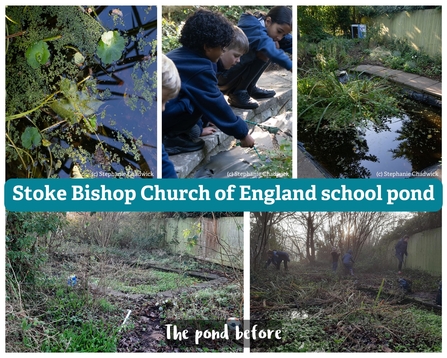
Stephanie Chadwick
Advice from the Team Wilder Community Ecologist:
Shade and clay tolerant wildflowers: There are shady areas of the pond garden where bramble, bindweed and spindle are dominant and the school would like to have these planted with more pollinator frinedly species. I suggest, for flowers throughout the year, considering adding Snow drops (winter), wild garlic (early spring) and native bluebells (mid spring), native foxglove and hemp agrimony (summer) nettle leaved bellflower and betony (late summer to early autumn), then common toadflax, yarrow and red campion (autumn).
Ferns also grow well in clay soils and are a great way of keeping more nuisance ground cover like common ivy at bay. Once the These will all need planting out in Autumn, and you can either use seeds or plugs. Bare in mind foxgloves are biennial so may need reseeding the second year for yearly appearance. All of these suggested are all shade or partial shade loving native species, that do well on clay heavy soils, and will entice more butterflies and insects into the area.
Tip: If you find in places the clay soil has become compacted, turn over the soil and add in mulched green waste and compost to improve the structure of the soil and drainage of the soil. I’d also suggest weeding by hand as opposed to with a rake, as the rake is likely going to be ripping all sorts of plants up and possibly disturbing any hidden amphibians or bees!
Consider adding bug hotels or some of the cut wood from the willow structures in piles to offer more habitat for invertebrates and amphibians. There are lots of willow whips growing at the moment that could be cut and bent into arches to make a barrier between the marginal plant area and the rest of the garden. You can purchase many of these species from Grow Wilder or Buy Native online.
Relining and planting the pond area:
The pond has a good overall structure and is very fit for purpose with paving on 3 sides and aquatic plants (yellow flag iris, water mint and frogbit) in the middle. There are clear tears in the liner which is preventing the pond from filling entirely- I think it would be worthwhile to drain the pond in the winter, remove the plants into bags or boxes temporarily, and reline the pond with a new EPDM liner. I’d just lay this on top of the previous liner, and ensure any rocks pushing through the previous liner are removed or smoothed over with wet sand or soil.
This would also be a great time to clear much of the detris layer from the base of the pond. If you can tuck the new liner underneath the existing paving slabs this may prevent needing to entirely remove and relay them. This may take some experimentation!
Tip: Remember when removing anything from the pond do so gently, slowly, and leave the removed plants and debris on the edge of the pond, or by the compost heap overnight so that any accidental visitors can escape to safety.
Once the pond has been relined, the marginal area where the soil has thinned is likely to become wetter, especially if the slope here is relandscaped using wet sand during the pond relining process. Adding a thicker layer of aquatic soil and planting the area more densely with marginal plants so that their roots bind the soil better also. Planting a groundcover species like creeping jenny or pennywort may also help secure the soil in this area, both of which enjoy wetter soils and can be submerged as the water level fluctuates. Some other flowering plants that are quite hardy and would enjoy the marginal area (remember to keep it nice and damp as much as possible if planting these) include marsh marigold, water forget-me-not, bogbean, pillwort or brooklime. When at the garden centre, be sure you’re choosing the species you intend and check that the species listed is accurate. Unfortunately, many garden centres stock invasive non native species that can wreak havoc when they escape into the wild.
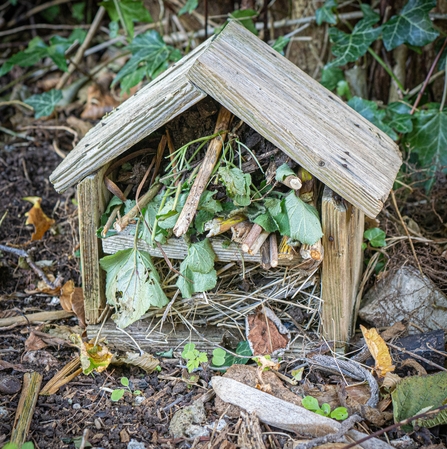
Stephanie Chadwick
School allotment area
Ecologically minded children get involved with teh school allotment. It is a lovely area, encouraging and demonstrating how food is grown, where it comes from and the benefits this brings to people and wildlife.
Hedgerow hero's
Plant a native hedgerow along the southeast fence: Planting hedgerow shrubs that will grow to form a dense boundary with flowers and fruits from Spring to October is recommended to establish a natural corridor for wildlife will significantly increase the number of birds and invertebrates that will start to use the space.
Hedgerows are a fantastic quality habitat for hedgehogs too and the planting event could be something that kids do with parents or as part of an extracurricular activity! You could also build a dead hedge along the base to create more of a barrier effect, using the willow clippings from the large willow structure in the playground too. Once matured, the hedges will not only keep improve berry abundance for birds in the area, but will provide a banquet for pollinators from Spring to Autumn when it’s established. Suitable species for planting as a hedgerow include:
- Hazel Corylus avellana
- Elder Sambucus nigra
- Hawthorn Crataegus monogyna
- Bird Cherry Prunus padus
- Raspberry Rubus ideasus
- Cherry Plum Prunus cerasifera
- Red currant or white currant bush Ribes rubrum
- Crab Apple Malus sylvestris
- Dog or Guelder rose. Rosa canina or Viburnum opulus

Stephanie Chadwick
Most of these will also produce edible fruits and/or dense flowers, feeding invertebrates, birds and mammals, whilst also providing nesting habitat and tasty treats to those who wish to enjoy them. Bramble scrub is a very beneficial habitat but can quickly take over hedgerows, so feel free to manage the bramble presence (if there becomes one) as you wish, ensuring all brush cutting and tree work is done outside of the nesting bird season (March – September).
Native hedgerow planting packs available from Hedges Direct: RSPB Approved Hedging Packs. Almost all of the species listed should be planted between October and March, in ground that is not frozen or saturated. Note, the ideal planting density is 5-7 plants per meter (including existing plants), and young whips and bare root plants should be planted as soon as they arrive to maximise survival! for each of the species you choose, please consult the individual cultivars growing preferences as they will vary between cultivars and species.
Any initial hedge cutting should be done between October and March to ensure nesting birds are not disturbed, subsequent pruning should be done over winter, every other year to ensure they are flowering and producing maximum fruit. A great resource for hedge care can be found here: Trimming and maintaining native hedges - Woodland Trust.
Resources
Be part of Team Wilder
Feeling inspired by this wildlife garden? Try something for yourself at home, in your community, school, business or land, no matter the size.
All actions for nature collectively add up and makes a difference for people and wildlife.
Share your actions for nature, like Stoke Bishop Church of England School, and motivate others to do the same.



















